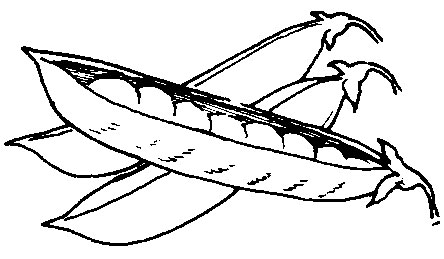Peas-Other
English, Snap, Snow Peas

English peas require early spring planting in order to mature before warm weather destroys them. Prepare the planting site in fall by adding all fertilizer except nitrogen. Prepare a high bed so that planting is possible when the rest of the garden may be too wet.
Some varieties of English peas have smooth seeds and others have wrinkled seeds. Smooth-seeded peas have a starchy flavor, even when young, and are used mostly for canning. Wrinkled-seeded peas are sweet when young and are slower to lose quality.
Soil temperatures at planting should be at least 45 °F for good germination. Plant seeds 1 inch deep and 1 inch apart. Allow 8 to 10 inches between double rows. Some form of support makes harvesting easier and keeps vines off the ground, reducing losses to pod rot. Tall varieties must be supported. Double rows of short vine types support themselves. Mulch to keep soil around roots cool and moist.
Grow sugar peas (snow peas) the same way as English peas. Harvest edible pods while still young and tender, and before peas enlarge. Edible-podded peas are also grown like English peas. Plants and pods resemble English peas, but the pods as well as the enlarged peas are eaten together without shelling. Sugar Snap, a 1979 AAS Gold Medal winner, has tall vines that require support. More recently developed varieties have short vines.
Varieties
English peas
- Alaska—smooth seed; canning type; early; 28-inch vines; 52 days.
- Green Arrow—midseason; wrinkled seed; 24- to 28-inch vine; 41⁄2-inch pods; 9 to 11 peas per pod; resistant to downy mildew and fusarium wilt; 68 days.
- Little Marvel—old variety; wrinkled seed; 15-inch vines; early; 3-inch pod; 6 to 8 peas per pod; dark green pea; 62 days.
- Thomas Laxton—early; wrinkled seed; 28- to 34-inch vine; 31⁄2-inch pod; 6 to 8 peas per pod; large pea; excellent quality; 61 days.
- Wando—midseason to late; small pod; 24- to 30-inch vine; tolerates some heat; 3-inch pod; 6 to 8 peas per pod; 70 days.
Snap peas
- Snappy—large pods; 8 to 9 peas; vines 6 feet; mildew resistant; 63 days.
- Sugar Ann—bush-type plant; 18 to 24 inches tall; AAS 1984.
- Sugar Bon—2- to 3-inch pods; weather tolerant; vines 18 to 24 inches; powdery mildew resistant; 56 days.
- Sugar Daddy—stringless; easy to pick; 74 days.
- Sugar Snap—4- to 6-foot vine; thick-walled, edible pod; 21⁄2- to 31⁄2- inch pods; wilt resistant; 68 days; AAS 1979.
Snow peas
- Dwarf Gray Sugar—early; 3-inch, light green pods; vines 2 feet tall.
- Mammoth Melting Sugar—4-inch pods; 4-foot wilt-resistant vines.
- Oregon Sugar Pod II—4-inch pods; 28-inch disease resistant vines.
Publications
News
Vegetable producers across the Southeast are invited to the 2025 Vegetable Field Day on July 23 at the Mississippi State University station in Verona, Mississippi.
If you grow your own vegetables, you will likely see at least a few pesky insects that want to feed on your plants. Slugs are one of the pests you may be noticing now.
Did you know yellow squash is in the pumpkin family and are 95 percent water?




